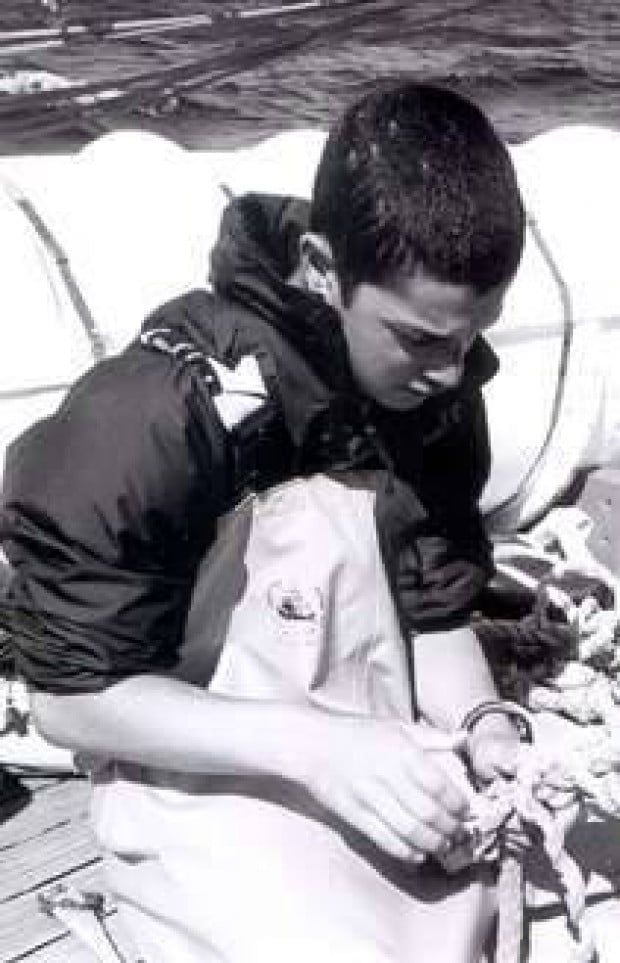Griffin Brown, a 14-year-old Malibu High School student, didn’t spend this summer at the beach the way most teenagers did. Instead, he embarked on an adventure that he will long remember.
Griffin set sail in Boston aboard the Spirit of Massachusetts, a 125-foot two-masted schooner built in 1984 for the Ocean Classroom. The ship is a replica of the high-speed Fredonia, a renowned 19th century Gloucester fishing schooner.
Bound for the Canadian Maritime Provinces via New England, Griffin was a participant of the Ocean Classroom’s Summer Term 2001 at Sea, the nation’s only fully accredited high school at sea program.
Recognizing his mother, Cathy Caballero, for discovering this challenging and educational sailing experience in Atlantic Monthly Magazine, Griffin wasn’t sure what he was in for when he decided to participate.
“The voyage turned out to be harder than I expected,” confesses the young teenager, who was gone for six weeks, “because it was a lot of work. There was so much to learn about sailing and I was responsible to keep up with my academic work, too.”
The Ocean Classroom is a complete semester at sea for high school students and post-graduates, fully accredited by Proctor Academy of Andover New Hampshire and offered in cooperation with South Street Seaport Museum and the Allied Whale Research Center. Grades, credits and transcripts are sent to the student’s high school. It has received national awards for excellence in education.
No stranger to the sea, Griffin grew up in Malibu, surfing since age 11, and has always had an appreciation for the ocean.
Right from the start, the 16 students he set sail with became a team. The 10 girls and six boys, ages 14-19, gathered in small groups to study marine science, maritime history, navigation, whaling history and research, as well as the fisheries of the regions, while calling at 10 ports. Their first landing was at St. John’s, Newfoundland, with more stops at fisheries in the Gulf of Maine, Bay of Fundy, St. Pierre and Lunenburg. Essential to learning was the history of the many ports visited.
A typical day on his seafaring journey was an early rise for six hours of morning watch with the professional crew, handling sails, hauling lines, navigating and steering within the traditions of the tall ships.
Next came three hours of demanding class study, collecting information, preparation for marine science projects, literature lessons and discussions, ship responsibilities, homework assignments, socializing and the long-awaited time to sleep.
“The ocean was the medium for learning, adventure and travel for each student’s personal discovery,” relates faculty member Devri Byrom, who specializes in marine science education and has been a major contributor to the courses of the Ocean Classroom and a leader in underwater research expeditions.
Detailing that students had a comprehensive study load at sea that included sea-related literature, with reading and discussion of Kipling’s “Captain Courageous” and Farley Mowat’s “The Boat That Wouldn’t Float,” she mentioned that sea poetry and sea shanties were learned and sung, too.
“Although Griffin was one of the youngest students, he was an active participant,” said Byron. “He and his partner, Victoria Ford from Tennessee, created an outstanding mixed-media replica of a traditional whaling vessel from gathered pieces of bark, collected on beaches, intermingled with toothpicks, then glued and varnished.”
She added, “Griffin was an able-bodied deck hand, who found personal satisfaction with navigation skills and seamanship.”
Although he thought the voyage quite long, “The whole trip will affect my life,” stated Griffin. “It made me more interested in sailing and more knowledgeable about the sea. I will always remember the excitement I felt when I climbed to the top of the mast to tend the sails. I also learned time management, as a way to balance learning, sailing, homework and sleep.”
His fascination with whales emerged into a project relating to issues pertaining to the whaling industry, specifically the humpback whales; conducting interviews in Newfoundland and Nova Scotia with experts in the field. Gloucester, the small fishing port where so many fishermen lost their lives, made a lasting impression on him. As his final project, Griffin developed a term paper on the “Evolution of the Dread Naught Battleship.”
The memory of these authentic sea experiences and the lessons relating to the ocean will remain with this Malibu youth for the rest of his life.

